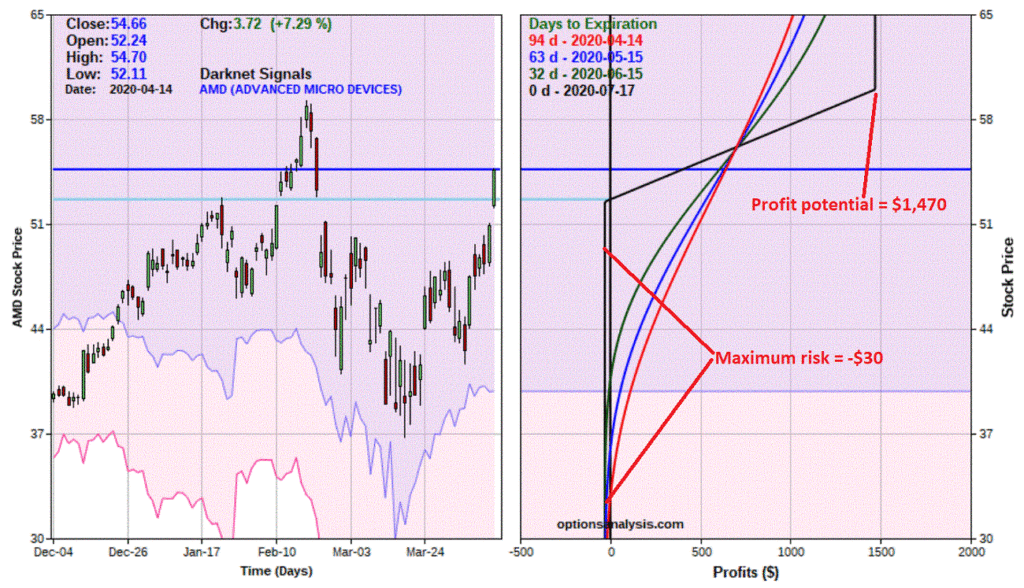In this article I wrote about an example intended to highlight a speculative trade designed to play the bullish side of the market for ticker AMD. The position involved simply buying a 2-lot of an out-of-the-money July call option.
Well, lo and behold AMD has jumped from $48.38 to $54.66 and the trade now looks like what you see in Figures 1 and 2.

Figure 1 – Original AMD trade (Courtesy www.OptionsAnalysis.com)

Figure 2 – Current risk curves for original AMD trade (Courtesy www.OptionsAnalysis.com)
Now here is where things can get interesting for an alert options trader. Recall form the original article that the tentative price target (generated by the Elliott Wave count using ProfitSource by HUBB) was $64 a share. So, there is a ways left to go before that happens.
However, an option trader does NOT necessarily have to “sit around and wait.” Rather than going into a long discussion of “could do this” or “might do that”, let’s look at one simple adjustment and see how the adjusted trade compares to the original position.
The Adjustment
To adjust this trade, we will simply sell 2 July 60 calls @ $3.60 apiece. For the record, this may be premature – ideally, we would want to sell them for $3.75, which is what we paid for the call options we bought. Selling the 60 calls at $3.75 or higher (maybe via a limit order?) would completely eliminate the risk of loss. But for the sake of completing the example, let’s continue.
New adjusted trade would look like what appears in Figures 3 and 4.

Figure 3 – Adjusted AMD position (Courtesy www.OptionsAnalysis.com)

Figure 4 – Risk curves for adjusted AMD position (Courtesy www.OptionsAnalysis.com)
The tradeoffs in making this adjustment are:
*The reduction of risk (the original trade can still lose -$750, the adjusted trade -$30 at most)
*You retain most of the upside potential up to AMD at $64 (at expiration, if AMD is at $64 a share the original trade shows a profit of roughly +$1,550, the adjusted trade would show a profit of $1,470)
If you DO make the adjustment:
*You retain much of the upside potential while eliminating most of the downside risk.
On the other hand:
*If AMD really does take off and soar the original position enjoys unlimited profit potential, while the adjusted trade has a maximum profit of +$1,470.
One other possibility:
*A little patience might allow AMD to rise even more, which could allow us to sell the July 60 call at a price higher than $3.75, which would completely eliminate the risk of loss.
Decisions, decisions….
Jay Kaeppel
Disclaimer: The information, opinions and ideas expressed herein are for informational and educational purposes only and are based on research conducted and presented solely by the author. The information presented does not represent the views of the author only and does not constitute a complete description of any investment service. In addition, nothing presented herein should be construed as investment advice, as an advertisement or offering of investment advisory services, or as an offer to sell or a solicitation to buy any security. The data presented herein were obtained from various third-party sources. While the data is believed to be reliable, no representation is made as to, and no responsibility, warranty or liability is accepted for the accuracy or completeness of such information. International investments are subject to additional risks such as currency fluctuations, political instability and the potential for illiquid markets. Past performance is no guarantee of future results. There is risk of loss in all trading. Back tested performance does not represent actual performance and should not be interpreted as an indication of such performance. Also, back tested performance results have certain inherent limitations and differs from actual performance because it is achieved with the benefit of hindsight.


Hello Jay,
Does an individual have to own the underlying in order to justify the adjustment of using your strategy of selling two 60 call puts. If the stock soars, the shares could be called away .
Douglas from Champaign, Now living in Texas.
Douglas, the adjustment discussed in the article was strictly related to the original trade discussed in the linked article. The idea was to consider the possibility of adjusting the initial position (Long 2 52.5 calls) in a way that reduces risk while still retaining meaningful upside potential. Holding stock shares of AMD was not any part of the equation. On a side note, if a trader uses profit targets as part of their method (i.e., “I will sell the stock shares I hold if the stock reaches $60 a share”) then it can make a great deal of sense to sell a call at the target price. a) if the target is hit the stock gets called away, and b) if the stock does not hit the target you collect the premiums for the calls you sold. But, yes, if you are playing for a big move, selling calls against your stock shares WILL limit your upside potential. Take Care, Jay
Jay, are the above ProfitSource illustrations with the- profit, max risk and breakeven highlighted in red, included in the software under the analyse tab or are those position statistics shown above from your brokerage ? I am looking into advantages of this software. . . . Douglas in Texas
The charts are from the ProfitSource software. Jay